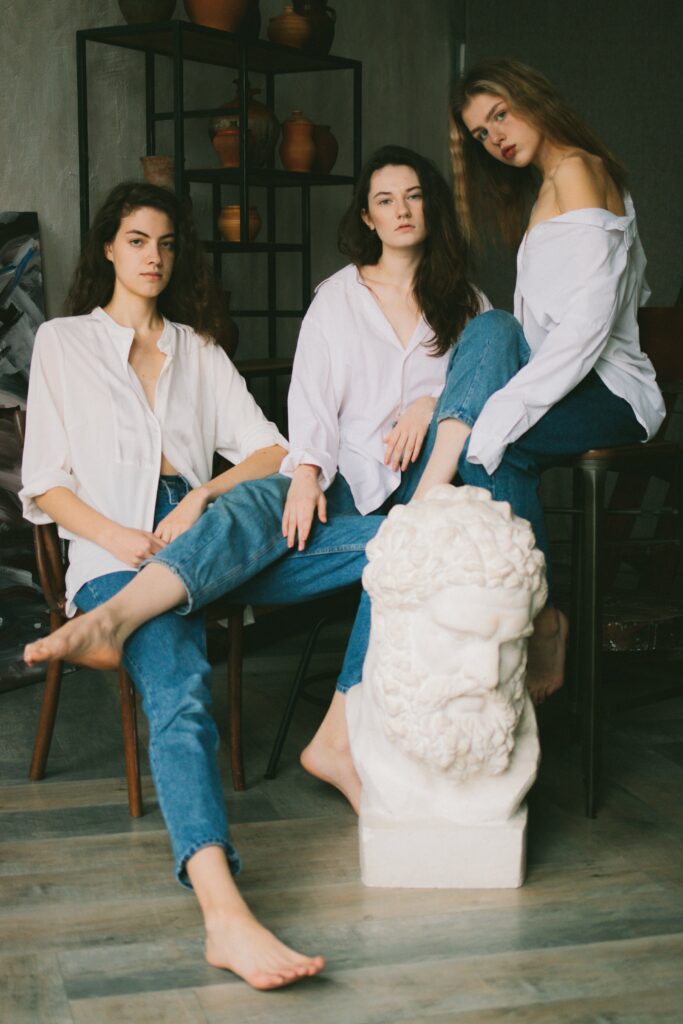Discover the essence of contemporary fashion with “Unleashing the Power of Style: Explore 7 dynamic trends shaping a vibrant and inclusive future. Dive into a world where creativity meets innovation in the ever-evolving landscape of modern fashion design.
Fashion transcends mere clothing, it is a language that articulates the spirit of a society. In contemporary fashion design, the terrain is in constant flux, molded by cultural changes, technological progress, and an expanding commitment to sustainability and inclusivity.
The blog “Unleashing the Power of Style: 7 Dynamic Contemporary Fashion Design Trends Shaping a Vibrant and Inclusive Future” delves into the nuanced aspects of current trends shaping modern fashion, unraveling the essential elements contributing to its dynamic essence. From innovative design approaches influenced by cultural shifts to the integration of cutting-edge technologies, the fashion landscape reflects the ever-evolving tapestry of societal values.
Furthermore, a heightened awareness of sustainability and inclusivity is steering the industry towards more responsible practices. As we navigate the intricate details of these trends, it becomes evident that modern fashion is a reflection of our times, mirroring the collective consciousness and aspirations of a globalized world.
1. Introduction to Contemporary Fashion Design Trends
Definition and Significance
Contemporary fashion design transcends mere style; it encapsulates the very essence of our present era. Grasping its significance requires unraveling the intricate threads that interconnect fashion with culture, technology, and individual expression. It serves as a mirror reflecting societal values, capturing the zeitgeist of our times.
Cultural influences shape design narratives, and technological advancements redefine possibilities, creating a dynamic landscape. Moreover, fashion becomes a canvas for individual expression, allowing people to communicate their identity and beliefs through clothing choices.

In this intricate interplay between culture, technology, and personal expression, contemporary fashion design emerges as a powerful form of cultural commentary, providing a visual language that speaks to the multifaceted nature of our modern existence.
Evolution over the Years
The evolution of contemporary fashion has been a captivating journey, transitioning from the avant-garde styles of the 20th century to the tech-infused designs of the 21st century. The 20th century witnessed a revolution in fashion, marked by bold experimentation and unconventional styles pioneered by designers like Coco Chanel and Yves Saint Laurent.
Fast forward to the 21st century, technology has become a driving force, influencing everything from design processes to interactive fashion experiences. Wearable tech, sustainable practices, and digital innovations have reshaped the industry, blurring the lines between fashion and technology. This blog delves into the fascinating transformation of fashion design, tracing the trajectory from avant-garde expressions to the integration of cutting-edge technologies that define the contemporary landscape.
2. Key Elements of Contemporary Fashion Design
Sustainable Fashion: A Driving Force
The fashion industry stands at a crucial crossroads, and at its center is the burgeoning emphasis on sustainability. This shift represents a defining moment, steering the industry towards more responsible practices. In this exploration, we delve into the paramount significance of sustainable fashion, unraveling its impact on the environment, social dynamics, and consumer choices.
From eco-friendly materials to ethical production processes, sustainable practices are reshaping the traditional fashion landscape. Notable brands are taking the lead, embracing a commitment to environmental and social responsibility. By spotlighting these trailblazing initiatives, we shed light on how sustainable fashion is not just a trend but a driving force that has the potential to redefine the industry, making it more conscious, accountable, and harmonious with the world we inhabit.
Inclusivity and Diversity in Design
Contemporary fashion is increasingly championing diversity across various spectrums, from embracing diverse body types to challenging traditional gender norms. This section delves into the transformative landscape of inclusivity within the fashion industry. Designers are at the forefront of this movement, pushing boundaries and breaking free from conventional molds.
The exploration of how fashion is becoming a platform for celebrating individuality and fostering inclusivity highlights a shift towards a more representative and empowering industry. As designers continue to challenge norms, they contribute to a fashion narrative that not only reflects the richness of human diversity but also promotes a more inclusive and accepting society.
You will also like : 2024 में सफलता की कुंजी “Fashion Designer Kaise Bane”
You may also like: Fine Arts –What Is It All About?
3. Technology in Contemporary Fashion Design
In an era characterized by technological dominance, its influence on fashion design is profound. This section delves into the far-reaching impact of technology, examining how innovations such as AI-driven design processes and virtual fitting rooms are shaping the future of the fashion industry.
Artificial Intelligence is revolutionizing the creative process, offering designers new tools and insights. Virtual fitting rooms, powered by advanced technologies, are redefining the shopping experience, allowing consumers to virtually try on clothing before making a purchase.
These technological advancements not only streamline design and retail processes but also open up new possibilities for creativity and consumer engagement. As fashion continues to embrace the digital age, the fusion of technology and design becomes a driving force, reshaping the industry landscape and enhancing the overall fashion experience.
Impact of Cultural Movements on Design

Fashion serves as a canvas that mirrors cultural movements. This analysis delves into the impact of streetwear, retro revivals, and global fusion on contemporary fashion design. Street wear, with its roots in urban culture, has transcended niche origins to become a mainstream force, shaping design aesthetics and influencing high fashion. Retro revivals tap into nostalgia, reintroducing classic styles with a modern twist, creating a bridge between the past and present.
Global fusion, a blending of diverse cultural influences, contributes to a rich and eclectic design landscape. Together, these trends showcase the dynamic interplay between fashion and culture, illustrating how designers draw inspiration from the streets, revive the past, and weave a global tapestry into the fabric of contemporary fashion.
4. Sustainable Fashion: A Driving Force
Importance of Sustainable Practices
With environmental concerns taking center stage, sustainable fashion has shifted from being a choice to a necessity. This exploration delves into the reasons why adopting eco-friendly practices is crucial for the future of the fashion industry.
As the fashion world grapples with the environmental impact of fast fashion, embracing sustainable practices becomes imperative for reducing ecological footprints. From minimizing waste and utilizing eco-friendly materials to promoting ethical production, the adoption of sustainable fashion practices not only addresses environmental concerns but also aligns with the changing values of conscious consumers.
In essence, the shift towards sustainability is not just a trend but a strategic move that recognizes the urgency of preserving our planet, making it an integral part of the fashion industry’s evolution and future success.
5. Inclusivity and Diversity in Design
In a departure from the era of one-size-fits-all, this discussion focuses on how designers are reshaping beauty standards through the creation of fashion that celebrates diverse body types.
The fashion industry is undergoing a transformative shift, acknowledging the beauty in various shapes and sizes. Designers are championing inclusivity, crafting garments that cater to a range of body types, challenging conventional norms, and fostering a more positive and realistic representation of beauty.
This evolution marks a significant departure from traditional standards, emphasizing that fashion should be accessible and empowering for individuals of all body shapes. As the industry continues to embrace diversity, it signals a departure from outdated norms and a commitment to reflecting the true diversity of the human form in the world of fashion.
Breaking Gender Norms
Contemporary fashion is challenging and blurring the lines of traditional gender norms. This section explores the evolving landscape of gender in fashion, from the emergence of gender-neutral clothing lines to the prevalence of androgynous designs.
Designers are redefining the concept of gender-specific fashion, acknowledging and embracing a spectrum of identities. The exploration of gender inclusivity in the fashion industry reflects a broader cultural shift towards a more inclusive and diverse understanding of identity.
As the lines between traditional masculine and feminine aesthetics become increasingly blurred, fashion becomes a powerful medium for self-expression, breaking free from restrictive gender norms and offering individuals the freedom to authentically represent their identities through clothing.
Cultural Representation in Fashion
The fabrics and patterns of contemporary fashion serve as a reflection of the global village. This exploration delves into the significance of cultural representation in design and its profound impact on the industry. As fashion becomes a global language, designers are increasingly drawing inspiration from diverse cultures, infusing garments with a rich tapestry of traditions and influences.
This emphasis on cultural representation not only adds vibrancy to design but also fosters a sense of inclusivity and appreciation for global diversity. In doing so, the fashion industry not only acknowledges the interconnectedness of our world but also recognizes the importance of celebrating and respecting the unique contributions of various cultures in shaping the evolving narrative of contemporary fashion.
6. Technology in Fashion Design
Role of AI in Design
The role of Artificial Intelligence (AI) in design is transformative. This brief section explores the impact of AI on the design process, revolutionizing how creators conceptualize and execute their ideas. AI algorithms analyze vast datasets, providing designers with valuable insights into trends and consumer preferences.
Moreover, AI-driven design tools enhance creativity by generating unique patterns, styles, and concepts. In the fashion industry, AI contributes to efficiency by automating tasks such as pattern recognition and color matching. The synergy between human creativity and AI’s analytical capabilities is shaping a new era in design, fostering innovation and pushing the boundaries of what’s possible.
As AI continues to evolve, its role in design is becoming increasingly integral, offering a powerful tool for designers to navigate and excel in the dynamic landscape of contemporary design.
Virtual Fitting Rooms
The future of trying on clothes is here. Virtual fitting rooms are changing the way consumers experience fashion, providing a personalized and convenient shopping experience.
3D Printing in Fashion
The integration of 3D printing in fashion represents a groundbreaking technological shift. This segment explores the impact of 3D printing on the fashion industry, revolutionizing the way garments are conceptualized, prototyped, and produced. 3D printing allows designers to bring intricate and complex designs to life with unprecedented precision.
This technology facilitates the creation of customizable, on-demand fashion, reducing waste and promoting sustainability. Moreover, 3D-printed materials open doors to innovative textures and structures that were once challenging to achieve through traditional methods.

7. Impact of Cultural Movements on Design
Streetwear Influence
Streetwear has evolved from its origins to become a global phenomenon, influencing and shaping contemporary fashion. This exploration delves into how the urban-inspired style of streetwear has left an indelible mark on the fashion landscape. Originating from the streets and subcultures, streetwear has transcended its niche beginnings to become a pervasive force in mainstream fashion.
Characterized by comfort, casual aesthetics, and a mix of high and low cultural influences, streetwear has challenged traditional fashion norms. Its impact is evident in the adoption of sneakers, hoodies, and graphic tees by luxury brands and high-end designers.
Retro and Vintage Resurgence
Retro and vintage styles are experiencing a resurgence, influencing contemporary fashion with a nostalgic twist. This revival brings classic aesthetics into the spotlight, shaping current design trends.
Global Fusion in Fashion
Cultural borders are fading, and fashion is embracing a global perspective. This section explores how designers are drawing inspiration from diverse cultures to create unique and inclusive designs.
8. Popularity of DIY and Upcycled Fashion
Rise of Do-It-Yourself Fashion
The rise of Do-It-Yourself (DIY) fashion marks a shift towards individual creativity and personal expression. With accessible tutorials and sustainable practices, DIY fashion empowers individuals to craft unique, handmade pieces, fostering a more inclusive and diverse fashion landscape.
Upcycling as a Sustainable Trend:
Upcycling is emerging as a sustainable trend in fashion, transforming discarded materials into new, high-quality garments. This environmentally conscious practice reduces waste, promotes resourcefulness, and contributes to a more sustainable and circular approach within the fashion industry.
Personalization in Design
From monogrammed accessories to customizable apparel, personalization is a key aspect of contemporary fashion. We explore how designers are offering unique, personalized experiences to consumers.
Youmay also like: Unveiling the Power of Blockchain Technology: Changing Future
You may also like: 2024 Navigating the NFT Landscape : Unveiling the complexity of Non-Fungible Tokens
You may also like: 20 METAVERSE Realities Redefining the Virtual Revolution
You may also like: Internet of Things (IoT)-10 Mind-Blowing Secrets
9. Fashion Industry Response to Contemporary Trends
Adaptation and Innovation
The fashion industry is no stranger to change. We discuss how designers and brands are adapting to contemporary trends and fostering innovation in design and production.
Challenges Faced by the Industry
While embracing new trends, the industry faces challenges. We explore the hurdles designers and brands encounter in staying relevant and sustainable.
Consumer Demand for Conscious Fashion
As consumers become more informed, their demands are changing. We delve into how the rise of conscious consumerism is shaping the priorities of the fashion industry.
10. Challenges and Criticisms in Contemporary Fashion
Fast Fashion Concerns
The fast fashion model comes under scrutiny. We discuss the environmental and ethical concerns associated with the rapid production and consumption of fashion.
Balancing Creativity and Commercial Viability
The business of fashion requires a delicate balance between creativity and commercial success. We explore how designers navigate this challenging terrain.
Addressing Cultural Appropriation Issues
In an interconnected world, cultural appropriation is a sensitive topic. We discuss how the fashion industry can approach cultural influences respectfully and responsibly.
Contemporary Couture Creations
Contemporary Couture Creations redefine fashion, seamlessly blending innovation and artistry. This avant-garde collection transcends traditional boundaries, fusing cutting-edge technology with exquisite craftsmanship. Each garment is a masterpiece, meticulously crafted to evoke emotions and challenge conventions. The designer’s visionary approach intertwines sustainability and style, using eco-friendly materials without compromising on opulence.
Bold silhouettes and intricate detailing characterize this collection, pushing the boundaries of conventional fashion norms. These creations are a testament to the designer’s commitment to pushing the industry forward while embracing individuality. Contemporary Couture Creations are not just garments; they are a celebration of diversity, a visual symphony that resonates with the modern spirit of self-expression and sustainability.
11. Future Projections in Fashion Design
Continued Focus on Sustainability
The future of fashion design is green as sustainability becomes a driving force, shaping design processes and influencing consumer choices. This shift towards eco-conscious practices reflects a growing awareness of environmental impact and a commitment to a more sustainable and responsible fashion industry.
Technological Advancements
From virtual reality fashion shows to innovative materials, technology will play an even more significant role in shaping the future of fashion design.
Shifting Consumer Expectations:
As consumers become more conscious, their expectations from the fashion industry evolve. We explore how designers will need to align with changing consumer values.
Modern Fashion Trends 2024:
Sustainable Chic: The fashion industry is embracing eco-friendly materials and ethical practices. From recycled fabrics to cruelty-free fashion, sustainability is the new black.
Tech-Infused Styles: With the rise of smart textiles, clothing is now interactive. Think color-changing fabrics, self-heating jackets, and even garments with embedded tech for personalized experiences.
Gender-Fluid Fashion: Breaking traditional norms, 2024 sees a surge in gender-neutral clothing. Designers are challenging the binary and offering inclusive styles that cater to diverse identities.
Nostalgia Resurgence: Retro vibes are making a comeback. Vintage-inspired pieces from the ’80s and ’90s are gracing the runways, combining nostalgia with a modern twist.
Bold and Bright: Vibrant colors and daring patterns dominate the scene. Fashionistas are opting for eye-catching hues, creating a visually striking and expressive fashion landscape.
Versatile Athleisure: The fusion of comfort and style continues. Athleisure evolves with multifunctional pieces suitable for both workouts and casual wear.
Cultural Fusion: Global influences are shaping fashion. Designs are drawing inspiration from diverse cultures, resulting in a rich tapestry of clothing that celebrates the world’s heritage.
Customization Craze: Personalization is key. From monogrammed accessories to bespoke clothing, individuals are seeking unique, one-of-a-kind pieces that reflect their personality.
In 2024, fashion is a dynamic blend of sustainability, technology, inclusivity, and self-expression, creating a diverse and exciting landscape for style enthusiasts.
Innovative Fashion Design Concepts:
Exploring the avant-garde realm of fashion, innovative design concepts redefine the boundaries of style. Unconventional materials, transformative silhouettes, and sustainable practices converge to create a harmonious blend of aesthetics and purpose. From 3D-printed garments that merge technology with couture to upcycled fashion breathing new life into discarded textiles, these concepts challenge conventional norms.
Adaptive, multifunctional pieces cater to a dynamic lifestyle, seamlessly transitioning from day to night. Embracing diversity, designers draw inspiration from global cultures, fostering a rich tapestry of creativity. The future of fashion lies in the hands of those daring to weave together tradition and cutting-edge ingenuity, shaping a sartorial landscape that transcends the ordinary.
latest sustainable fashion designs:
The latest sustainable fashion designs seamlessly blend style and eco-consciousness. Designers are embracing innovative materials like recycled fabrics, organic cotton, and upcycled materials to create chic and environmentally friendly pieces. From bold patterns to minimalist aesthetics, these designs cater to diverse tastes while prioritizing sustainability.
Circular fashion concepts, emphasizing durability and recyclability, are gaining popularity. Ethical practices in production, fair labor, and reduced carbon footprint are integral to these collections. The runway is adorned with garments that not only make a fashion statement but also contribute to a greener future, proving that style and sustainability can coexist harmoniously.
Futuristic Apparel Design Ideas:
Imagine garments that seamlessly integrate technology, like smart fabrics that change color based on your mood or temperature-regulating materials that adapt to your surroundings. Picture holographic accessories that project digital displays or interactive clothing with embedded sensors that respond to gestures. Embrace sustainability with garments made from innovative eco-friendly materials, featuring built-in solar panels or biodegradable fibers.
Explore modular fashion, where garments can transform into multiple styles with detachable elements. Embrace 3D-printed clothing tailored to individual measurements, blending futuristic aesthetics with personalized comfort. Integrate augmented reality elements into apparel for an immersive visual experience. The future of fashion is a fusion of style and cutting-edge technology, pushing the boundaries of creativity and functionality.
12. Fashion Design Education in the Contemporary Landscape
Incorporating Modern Design Principles
Design education is adapting to the times. We discuss how contemporary fashion design programs are incorporating modern principles, including sustainability and technology.
Emphasis on Ethical Practices
Ethical practices take center stage in the latest fashion landscape. Designers are prioritizing fair labor, sustainable sourcing, and transparent production processes. The emphasis on creating a positive social impact extends beyond aesthetics, with a focus on empowering communities and ensuring ethical treatment of workers. This shift reflects a commitment to responsible fashion, where the journey from raw materials to the finished garment aligns with ethical values. Consumers are increasingly drawn to brands that champion fairness, creating a demand for fashion that not only looks good but also embodies ethical principles. The runway is now a showcase for a new era of conscientious and compassionate style.
13.Interviews with Leading Contemporary Fashion Designers
Insights into Their Design Philosophy
We go behind the scenes with interviews featuring prominent contemporary fashion designers, gaining insights into their creative processes and design philosophies.
Challenges Faced and Overcome
Designers confront numerous challenges on their creative journeys. Through these interviews, gain valuable insights as designers candidly share personal experiences, offering a glimpse into the obstacles they’ve faced and conquered throughout their careers, providing inspiration for aspiring designers navigating their own paths.
Advice for Aspiring Designers
Aspiring to enter the world of fashion design? Find invaluable advice and words of wisdom from industry leaders in these interviews. Gain insights that can guide and inspire your journey into the dynamic realm of fashion design.
14. Conclusion
Embarking on a journey through contemporary fashion design trends, we’ve examined the dynamic interplay of sustainability, inclusivity, technology, and cultural influences. In the face of challenges, the industry’s embrace of innovation holds promise for a future fashion landscape that is not only diverse but also socially and environmentally conscious.
As designers and consumers alike contribute to this transformative shift, the evolving narrative of fashion reflects a commitment to a more responsible and inclusive global community.
15. Frequently Asked Questions (FAQs)
Q1. What defines contemporary fashion design?
Q2. How are designers incorporating sustainability into their practices?
Q3.What role does technology play in modern fashion design?
Q4. Why is inclusivity important in contemporary fashion?
Q5. How can aspiring designers stay relevant in the ever-changing fashion landscape?
